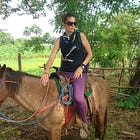Rooted & Rising is a weekly newsletter on intentional living, deconstructing limiting beliefs, and embracing self-discovery—designed for those with chronic illness and neurodiversity.
If you missed the last edition, we explored the limiting belief that chronic illness prevents engaging in new experiences. Check it out below!
I've come to appreciate the process of goal-setting, especially now that I no longer see it as an "all or nothing" pursuit. I recognize that setbacks and adjustments aren’t failures—they’re an inherent part of the journey.
For those navigating nervous system dysregulation, burnout, trauma*, neurodiversity, or chronic illness, traditional goal-setting frameworks can feel rigid and overwhelming.
Frameworks like SMART goals, while useful for some, can inadvertently increase stress or diminish motivation, making it harder to stay engaged.
* Like coaching, goal-setting is present- and future-focused. But our nervous systems—shaped by past experiences—deeply influence how we approach growth, relationships, and work. This is why mind-body integration is essential when setting and pursuing goals.

What is gentle goal-setting?
Gentle goal-setting prioritizes sustainable progress over perfection. Some refer to this as “fuzzy goals,” a flexible approach that adapts when circumstances—like health or environment—are in flux. There are two ways to look at gentle goal setting:
The Approach – How we set goals
Being realistic with expectations means we’re setting goals based on current capabilities and priorities, breaking goals into small (sometime bite-sized) steps, actually celebrating every accomplishment, and taking into consideration health changes or external influences.
The Purpose – Why we set goals
Shifting from outcome-based achievement to process-oriented growth emphasizes the journey—learning, adapting, and enjoying the process. Rather than chasing a fixed outcome, it’s about how we want to feel along the way—more engaged, fulfilled, or empowered—while creating space for discovery.
Focusing on process-oriented growth
Process-oriented growth doesn’t mean we don’t have goals and aspirations, it just means our success isn’t solely tied to a specific outcome. Let me explain.
In 2020, I hit a low point with my health—constant burning pain, fatigue, cognitive issues etc. Determined to put fibromyalgia and chronic pain into remission, I threw myself into biohacking. I consumed endless resources, saw specialists when I could, took many supplements, and experimented with countless diets. If there was a potential fix, I tried it.
Some of these efforts helped, but they didn’t lead to significant improvement. Why? Because I wasn’t addressing the chronic stress that had accumulated. In fact, my hyper-fixation on healing only added more stress. I wasn’t enjoying the process—I was pushing myself relentlessly for results.
Real progress came when I shifted my focus to supporting my nervous system and emotional regulation. I learned to restore balance, manage my capacity, and release stress activation. Over time, my health improved—not in the way I originally envisioned, but in ways that actually mattered.
I didn’t achieve full remission. I still experience daily pain and occasional flares. When I was outcome-focused, this would have felt like failure. A single flare could make me feel like I was back at square one. My goal had been too rigid, relying on factors beyond my control.
Now, through process-oriented growth, I measure success differently. I’ve improved my quality of life, deepened my understanding of my body, cultivated self-compassion, adapted when needed, and learned to see flares as a cue to lean into rest.
The journey itself is where transformation happens.
Learning a new language with chronic illness
For years, I had a big goal: to become fluent in Spanish. At one point, I even lived and worked in Colombia, giving me extra motivation to improve my communication in both social and professional settings.
When I first moved there, I barely spoke Spanish beyond a few survival phrases. At the same time, I was struggling with newly developed fibromyalgia, which made symptom management a daily challenge. I noticed others around me picking up the language much faster, and over time, I developed a limiting belief—maybe I just wasn’t capable of learning a new language.
What I hadn’t accounted for were the barriers that made language learning uniquely difficult with chronic illness: fatigue, pain, cognitive dysfunction (brain fog), sleep issues, and stress sensitivity.
The real shift came when I started viewing language learning through the lens of the nervous system. This helped me take a more gentle, sustainable approach—and as a result, I made more progress. Here are a few key insights:
Regulation & Learning – The nervous system has a “sweet spot” (often called the Window of Tolerance) where we can handle stress and absorb new information effectively. When we go outside this, we may enter a fight-or-flight or freeze state, making learning, communication, and decision-making much harder. I was experiencing high anxiety and overwhelm, which often caused me to freeze during Spanish conversations.
Perfectionism & Procrastination – Perfectionism is often considered a nervous system response. It can show up as a fight response, where heightened activation fuels productivity to combat anxiety, or as a freeze response, where fear of mistakes leads to avoidance. Both can contribute to procrastination and ultimately block progress. If I made a mistake when speaking Spanish, I was hard on myself—making me less likely to practice.
Recognizing Body-Brain Limits – Everyone has unique physical, mental, and energetic limits. Sustainable progress happens when we work within a stretch zone—challenging ourselves while staying within our Window of Tolerance to avoid overwhelm. I had been trying to run before I could walk, juggling both language learning and working in that language at the same time. Scaling back and adjusting my approach made the process much more manageable.
A gentle approach to language learning
By shifting my perspective, I moved away from self-judgment and towards a more compassionate, process-oriented approach. Learning a new language was still challenging, but it became possible once I worked with my nervous system instead of against it. Here are some of the changes I made:
Bite-sized learning: Instead of long, overwhelming study sessions, I started with 10- to 15-minute blocks of focused learning. Structured resources, like YouTube videos or lesson plans, helped with task initiation so I wasn’t wasting energy deciding what to study.
Play & variety: I engaged multiple senses—listening, reading, writing, and speaking—to make learning more dynamic. My Spanish teacher introduced poetry, music, storytelling, and games that required focus without triggering anxiety. Connecting play to learning made the process more enjoyable and motivating!
Connection over perfection: I let go of the pressure to form flawless sentences (which wasn’t happening anyways) and instead focused on real-life communication. Practicing in safe, low-pressure environments helped me see mistakes as learning opportunities rather than failures.
Energy management: I became more mindful of when my brain felt sharpest and adjusted my study sessions accordingly. This prevented me from pushing through exhaustion or brain fog, which only made learning more difficult.
Repetition for retention: Brain fog made memorization challenging, so I built repetition into my daily routine. I labeled household items in Spanish, used flashcards, and made a habit of repeating new words multiple times throughout the week—even if just to myself.
Nervous system support: Stress limits the brain’s ability to process new information. Tools like EFT tapping, deep breathing, and other somatic practices helped me regulate my nervous system, making learning more achievable.
Celebrate small wins: I stopped measuring success by fluency alone. Instead, I celebrated moments of connection—whether it was laughing through a conversation, understanding a song lyric, or feeling more confident expressing an opinion. Ultimately, connection and cultural exchange were what drew me to learning Spanish in the first place.
Pursuing your goals through a gentle approach
Here are some key insights I’ve learned—both personally and alongside clients—when it comes to setting and pursuing gentle goals.
Identify your core drive: Asking, “What do I actually want to achieve?” helps ensure your goals are aligned with your values and true desires.
For example, initially my goal was to put fibromyalgia into remission—a difficult and unpredictable outcome. But at its core, what I actually wanted was a better quality of life and more capacity for daily activities.
Similarly, my goal of fluency in Spanish was actually about connection and cultural exchange. Shifting my focus to why I wanted these things made my goals feel more fulfilling, flexible, and ultimately more achievable.
Nervous system regulation & limiting beliefs: Tools like timers, checklists, body-doubling, and reducing distractions can support executive function and help maintain physical and mental limits. But tools alone aren’t enough. Our mindset and nervous system regulation play a crucial role in staying engaged and making progress.
Done is better than perfect: Tasks expand to fill the time and energy we give them. Setting gentle boundaries around time and effort prevents perfectionism, fatigue, and burnout from slowing or stopping progress.
Reflect and review: Schedule check-ins to assess progress, reflect on what’s working, and adjust goals as needed. This helps you stay aligned with your values, priorities, and capacity, rather than getting lost in busy work that doesn’t actually support your bigger goal.
Adaptability is the essence of consistency: Consistency is often framed as discipline and persistent effort, but true consistency is about adaptability —finding sustainable ways to show up, even when circumstances shift. If you are pressed for time or energy, exploring alternative methods to incorporate your goals into your daily routine can foster intrinsic motivation.
For example, if you don’t have the capacity for a language lesson, you could find creative ways to incorporate learning into things you’ll already be doing. This could be as simple as naming ingredients aloud while you cook or narrating what you see during a walk.
A few months back I had the pleasure of chatting with Elizabeth Curtis about gentle goal setting on her Alive with Chronic Illness Podcast.
We discussed identifying and setting realistic goals (including language learning) and how we can step away from the pressure to keep achieving more and instead, celebrate all the milestones and successes along the way.
What’s a gentle goal you’re working towards? What’s a small win you’re celebrating this week? 🎉
Gentle hug,
Caitlin
Hi I’m Caitlin (she/they), and I help mission-driven humans (and their bodies) pursue meaningful goals—without burning out.
Curious if we’re a good fit? Book a free 30-min discovery call here.
New Offer: Pocket Coaching
Looking for support without the structure of a full session? Pocket Coaching gives you a full day of real-time voice/text coaching via the Voxer app, plus two business days of follow-up support. Book directly here.





